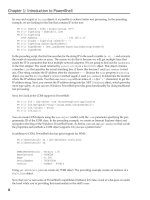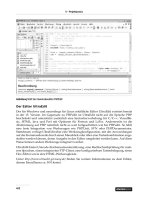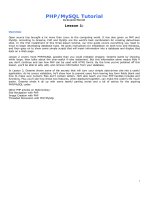PHP 5/MySQL Programming- P52 pptx
Bạn đang xem bản rút gọn của tài liệu. Xem và tải ngay bản đầy đủ của tài liệu tại đây (179.33 KB, 5 trang )
233
C
h
a
p
t
e
r 7 W
r
i
t
i
n
g
P
r
o
g
r
a
m
s
w
i
t
h
O
b
j
e
c
t
s
It’s not that amazing that the function can generate all that HTML code; the code
is fairly predictable. What’s neat is the way the
SuperHTML object knew what its
title and headline should be. The phrase
Basic Super Page is the string that
initializes the
SuperHTML object. The buildBottom() method is even easier than
buildTop(), because it simply adds some boilerplate page-ending code:
</body>
</html>
Writing Out the Page
The buildTop() and buildBottom() directives feel a lot like function calls, because
they are very similar to the functions you’ve already created and used many
times. However, these functions are designed to work within the context of a par-
ticular object. A function attached to an object is referred to as a method of the
object. A
cow object might have moo() and giveMilk() methods.
The syntax for referring to methods in PHP is with the arrow syntax (->). There isn’t
one key to indicate this operator. It is the combination of the dash and the greater-
than symbol.
Note that neither buildTop() nor buildBottom() actually write any code to the
screen. Instead, they prepare the page as a long string property inside the object.
SuperHTML has a method called getPage() that returns the actual HTML code for
the page. The programmer can then save the code to a file, print it out, or what-
ever. In this case, the following line simply prints out the results of the
getPage()
method:
print $s->getPage();
Working with the Title Property
It’s possible to designate a title when you create a SuperHTML object, but what if
you want to change the title later? Objects can store code in methods, and they
can also store data in properties. A property is like a variable attached to a par-
ticular object. The
SuperHTML object has a title property. The cow object might have
a
breed property and an age property. The Properties.php page featured in Figure
7.2 illustrates this feature.
The
Property.php program begins exactly like the Basic Super page you saw ear-
lier. I even created the
$s variable with the same initial value (Basic Super Page).
HINT
When I created the SuperHTML object, the title property was automatically set to
Basic Super Page. It’s possible to directly change the title, like this:
$s ->title = “new title”;
As you see when you look at the SuperHTML code itself, this approach can cause
some problems. It’s generally better to use special methods to get information to
and from properties. Take a look at the following code for Property.php and you’ll
see a better way to change a property value.
<?
include “SuperHTMLDef.php”;
$s = new SuperHTML(“Basic Super Page”);
$s->setTitle(“I changed this”);
$s->buildTop();
print “The title is now “ . $s->getTitle();
$s->buildBottom();
print $s->getPage();
?>
The $s->setTitle() method allows me to add a new value to a property. The
$s->getTitle() method gets a value from a property. These special methods are
usually called
access methods
because they allow access to properties. I’ll explain
more about access methods later in this chapter when you start building your
own object.
234
P
H
P
5
/M
y
S
Q
L
P
r
o
g
r
a
m
m
i
n
g
f
o
r
t
h
e
A
b
s
o
l
u
t
e
B
e
g
i
n
n
e
r
FIGURE 7.2
I created this page
with one title
and then changed
the title.
235
C
h
a
p
t
e
r 7 W
r
i
t
i
n
g
P
r
o
g
r
a
m
s
w
i
t
h
O
b
j
e
c
t
s
Adding Text and Tags with SuperHTML
The SuperHTML object makes it easy to build a basic HTML framework, but you
always need other kinds of tags.
SuperHTML has some general methods for adding
various kinds of tags and text to a document. Figure 7.3 illustrates a page using
these features.
One of the primary features of
SuperHTML is the way it separates the creation of a
Web page from its display. You want to be able to easily generate a page and then
display it onscreen, write it to a file, or do whatever else you want with it. For
that reason, you won’t simply print things out. Instead, you’ll keep adding stuff
to the
SuperHTML object and then print the whole thing out when you’re done.
That means you need some mechanism for adding things to the page. The
SuperHTML
object contains more than 25 methods for adding various kinds of objects to the
document. (Don’t panic. Most of them are really very simple.) Two methods in par-
ticular are extremely useful. Look at the code for
AddText.php and see what I mean.
FIGURE 7.3
This page includes
some text and
HTML tags.
IN THE REAL WORLD
If you’ve programmed in languages like Visual Basic, C#, or Java, you might
argue that you have directly accessed properties without using these access
methods. The truth is, access methods in these languages are usually behind
the scenes. When you assign a value to an object property, the appropriate
access method is automatically implemented.
236
P
H
P
5
/M
y
S
Q
L
P
r
o
g
r
a
m
m
i
n
g
f
o
r
t
h
e
A
b
s
o
l
u
t
e
B
e
g
i
n
n
e
r
<?
include “SuperHTMLDef.php”;
$s = new SuperHTML(“Adding Text and Tags”);
$s->buildTop();
$s->addText(“This is ordinary text added to the document”);
$s->addText(“<div>You can also add HTML code <hr> like the HR above</div>”);
$s->h3(“Use h1-h6 methods to add headings”);
$s->tag(“i”, “this line is italicized”);
$s->buildBottom();
print $s->getPage();
?>
The addText() method expects a string as its only parameter. It then adds that
text to the document in memory. As you can see, the text can even contain HTML
data. You can also pass multi-line strings or text with interpolated variables.
The
addText() method is really the only method you need in order to build the
page in memory. However, the point of the
SuperHTML object is to make page devel-
opment faster and easier. I actually use the
addText() method when I need to add
actual text to a page or when I need a tag I haven’t yet implemented in
SuperHTML.
Look at the following line:
$s->h3(“Use h1-h6 methods to add headings”);
This code accepts a string as a parameter, then surrounds the text with <h3></h3>
tags and writes it to the document in memory. Of course, there are similar methods
for h1 through h6. You could expect similar methods for all the basic HTML tags.
I didn’t create shortcuts for all the HTML tags, for two reasons. One reason is once
you see the mechanism for creating a new tag method, you can modify
SuperHTML
very easily to have methods for all your favorite tags. The other reason I didn’t
make shortcuts for all the tags is the very special method described in the fol-
lowing line:
$s->tag(“i”, “this line is italicized”);
The tag() method is a workhorse. It expects two parameters. The first is the tag
you wish to implement (without the angle braces). In this case I want to italicize,
so I’m implementing the
i tag. The second parameter is the text you want sent
to the document. After this function is completed, the document has the following
text added to the end:
<i>this line is italicized</i>
If you look at the HTML source code for AddText.php, you see that’s exactly what
happened.
The great thing about the
tag() method is its flexibility. It can surround any text
with any tag.
Creating Lists the SuperHTML Way
Even if you only use the addText() and tag() methods, you can create some really
nice, flexible Web pages. However, this object’s real power comes with some spe-
cialized methods that solve specific display problems. When you think about it,
a lot of PHP constructs have natural companions in the HTML world. For exam-
ple, if you have an array of data in PHP, you frequently want to display it in some
form of HTML list. Figure 7.4 demonstrates a page with a number of lists, all auto-
matically generated from arrays.
You’ve probably already written code to generate an HTML list from an array.
Although it’s not difficult, it can be tedious. It’d be great if you could just hand
off that functionality and not worry about it when you’ve got other problems to
solve. The
SuperHTML object has exactly that capability. The code list.php illus-
trates a number of ways to do this.
237
C
h
a
p
t
e
r 7 W
r
i
t
i
n
g
P
r
o
g
r
a
m
s
w
i
t
h
O
b
j
e
c
t
s
FIGURE 7.4
These HTML lists
were created
automatically from
arrays.









